Seat Mii 2012 Owner's manual
Manufacturer: SEAT, Model Year: 2012, Model line: Mii, Model: Seat Mii 2012Pages: 308, PDF Size: 4.13 MB
Page 241 of 308

239
Practical information
ProblemPossible causes,
among othersPossible solution
The electrical
equipment is not
working.Vehicle battery flat.Charge the battery
⇒ page 193.
Fuel tank level insuffi-
cient.Refuel ⇒ page 171.
A fuse is blown.Check fuse and change if
necessary ⇒ page 261.
Fuel consumption
higher than nor-
mal.
– Short trips.
– “Irregularities in the
accelerator pedal”.– Avoid short trips.
– Foresight when driving.
– Press the accelerator even-
ly.
Electrical equipment
connected.Switch off any unnecessary
electrical equipment.
Fault in engine man-
agement.Have the fault rectified
⇒ page 236.
Tyre pressure too low.Adjust tyre pressure
⇒ page 210.
Driving on hills.No direct solution.Driving with a heavy
load.No direct solution.
Driving at an excessive
engine speed.Shift up a gear.
Vehicle diagramPrior to a journey...While drivingCare, cleaning and mainte-
nanceIf and whenTechnical Data
Page 242 of 308

240Practical information
In case of emergency
Introduction
Additional information and warnings:
● Braking, stopping and parking ⇒ page 134
● Emergency locking and unlocking ⇒ page 243
● Vehicle tools ⇒ page 246
● Change wheel ⇒ page 250
WARNING
A faulty vehicle in traffic represents a risk of accident for the driver and
for other road users.
● Stop the vehicle safely as soon as possible. Park the vehicle a safe
distance from surrounding traffic to lock all the doors in case of an emer-
gency. Turn on the hazard warning lights to warn other road users.
● Never leave children or disabled people alone in the vehicle if the
doors are to be locked. In case of an emergency, passengers will be trap-
ped inside the vehicle. Individuals locked in the vehicle can be exposed
to very high or very low temperatures.
Protecting yourself and securing the vehicle
Fig. 130 Dash panel:
Button to switch on and
off the hazard warning
lights system
Always fulfil legal requirements for securing a broken down vehicle. In a
number of countries it is now obligatory, for example, to turn on the hazard
warning lights and use a reflective safety vest ⇒ page 242.
Checklist
For your own safety and that of other passengers, the following points
should be observed in the order given ⇒
:
1. Park the vehicle a safe distance from traffic and on suitable ground ⇒
.
2. Turn on the hazard warning lights system with the button
⇒ Fig. 130.
3. Apply the handbrake firmly ⇒ page 134.
4. Put the gearbox lever in neutral or the selector lever in position P ⇒ page 124.
5. Switch off the engine and remove the key from the ignition.
6. Have all occupants leave the vehicle and move to safety, for example behind a guard rail.
Page 243 of 308

241
Practical information
Checklist (Continued) 7. When leaving the vehicle, take all keys with you.
8. Place an emergency warning triangle to indicate the position of your vehicle to other road users.
9. Allow the engine to cool and check if a specialist is required.
When being towed with the hazard warning lights system on, a change in
direction or traffic lane can be indicated as usual using the turn signals lev-
er. The hazard lights will be interrupted temporarily.
Examples of when to use the hazard warning lights system:
● If the vehicles ahead suddenly slow down or reach the end of a traffic
jam, to warn the vehicles behind.
● In case of an emergency.
● If the vehicle breaks down.
● When tow-starting or towing.
Always comply with the applicable laws regarding the use of hazard warn-
ing lights.
If the hazard warning lights system is not working, you must use an alterna-
tive method of drawing attention to your vehicle. This method must comply
with traffic legislation.
WARNING
Failure to follow the checklist prepared for your own safety could lead to
accidents and severe injuries.
● Always complete the operations given in the checklist and observe
the general rules of safety.
WARNING
The components of the exhaust system reach very high temperatures.
This could cause a fire and considerable damage.
● Always park your vehicle so that no part of the exhaust system can
come in contact with flammable materials (such as dried grass or fuel).
Note
The vehicle battery will discharge and run down if the hazard warning lights
remain on for too much time (even with the ignition turned off).
Note
For some vehicles, the brake lights will blink when braking suddenly at
speeds of approximately 80 km/h (50 mph) to warn vehicles behind. If brak-
ing continues, then the hazard warning lights system will automatically be
turned on at the speed of less than approximately 10 km/h (6 mph). The
brake lights remain lit. Upon accelerating, the hazard warning lights system
will be automatically turned off.
Vehicle diagramPrior to a journey...While drivingCare, cleaning and mainte-
nanceIf and whenTechnical Data
Page 244 of 308
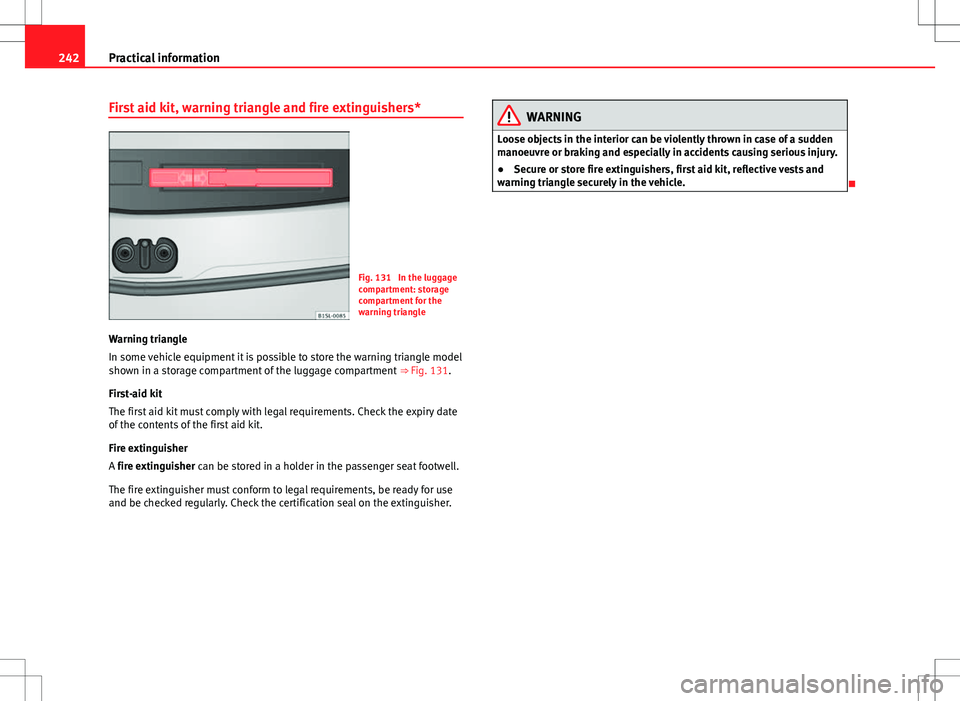
242Practical information
First aid kit, warning triangle and fire extinguishers*
Fig. 131 In the luggage
compartment: storage
compartment for the
warning triangle
Warning triangle
In some vehicle equipment it is possible to store the warning triangle model
shown in a storage compartment of the luggage compartment ⇒ Fig. 131.
First-aid kit
The first aid kit must comply with legal requirements. Check the expiry date
of the contents of the first aid kit.
Fire extinguisher
A fire extinguisher can be stored in a holder in the passenger seat footwell.
The fire extinguisher must conform to legal requirements, be ready for use
and be checked regularly. Check the certification seal on the extinguisher.
WARNING
Loose objects in the interior can be violently thrown in case of a sudden
manoeuvre or braking and especially in accidents causing serious injury.
● Secure or store fire extinguishers, first aid kit, reflective vests and
warning triangle securely in the vehicle.
Page 245 of 308
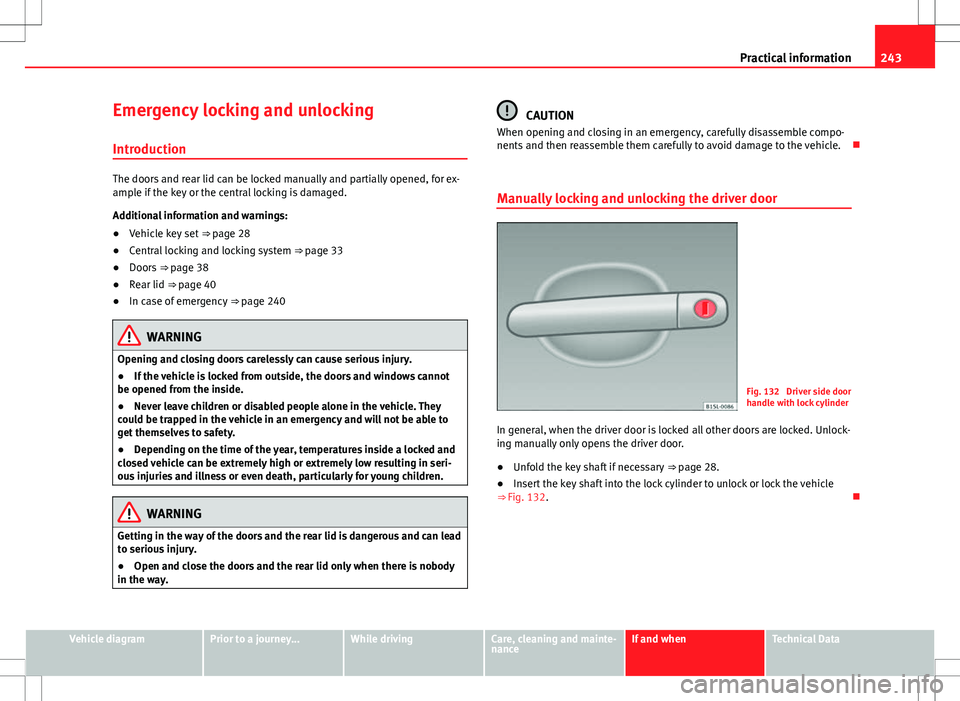
243
Practical information
Emergency locking and unlocking Introduction
The doors and rear lid can be locked manually and partially opened, for ex-
ample if the key or the central locking is damaged.
Additional information and warnings:
● Vehicle key set ⇒ page 28
● Central locking and locking system ⇒ page 33
● Doors ⇒ page 38
● Rear lid ⇒ page 40
● In case of emergency ⇒ page 240
WARNING
Opening and closing doors carelessly can cause serious injury.
● If the vehicle is locked from outside, the doors and windows cannot
be opened from the inside.
● Never leave children or disabled people alone in the vehicle. They
could be trapped in the vehicle in an emergency and will not be able to
get themselves to safety.
● Depending on the time of the year, temperatures inside a locked and
closed vehicle can be extremely high or extremely low resulting in seri-
ous injuries and illness or even death, particularly for young children.
WARNING
Getting in the way of the doors and the rear lid is dangerous and can lead
to serious injury.
● Open and close the doors and the rear lid only when there is nobody
in the way.
CAUTION
When opening and closing in an emergency, carefully disassemble compo-
nents and then reassemble them carefully to avoid damage to the vehicle.
Manually locking and unlocking the driver door
Fig. 132 Driver side door
handle with lock cylinder
In general, when the driver door is locked all other doors are locked. Unlock-
ing manually only opens the driver door.
● Unfold the key shaft if necessary
⇒ page 28.
● Insert the key shaft into the lock cylinder to unlock or lock the vehicle
⇒ Fig. 132.
Vehicle diagramPrior to a journey...While drivingCare, cleaning and mainte-
nanceIf and whenTechnical Data
Page 246 of 308
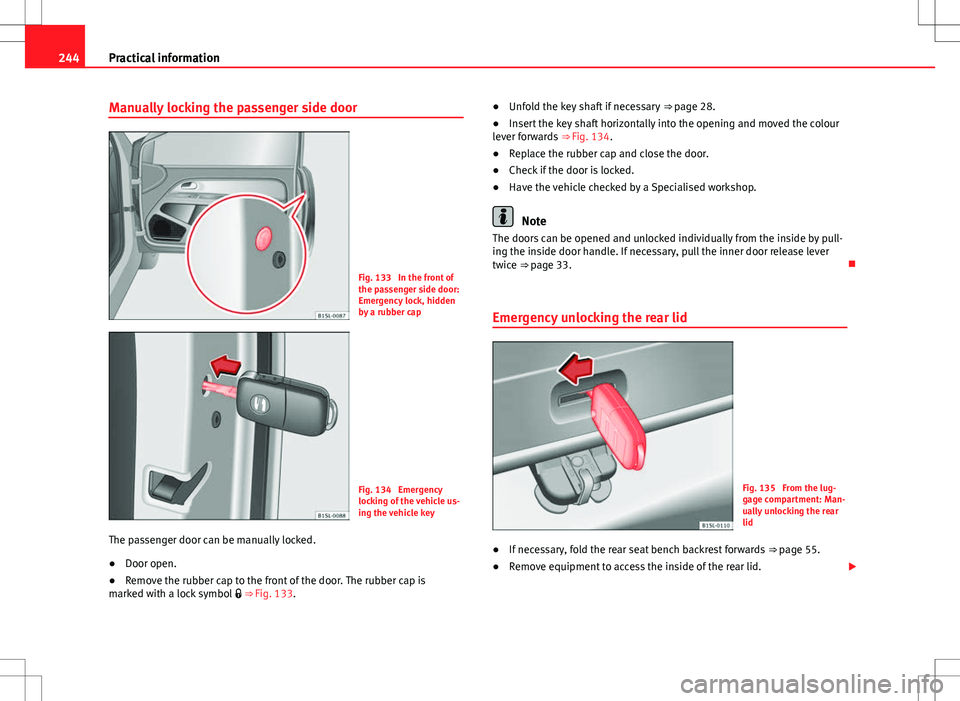
244Practical information
Manually locking the passenger side door
Fig. 133 In the front of
the passenger side door:
Emergency lock, hidden
by a rubber cap
Fig. 134 Emergency
locking of the vehicle us-
ing the vehicle key
The passenger door can be manually locked.
● Door open.
● Remove the rubber cap to the front of the door. The rubber cap is
marked with a lock symbol ⇒ Fig. 133. ●
Unfold the key shaft if necessary ⇒ page 28.
● Insert the key shaft horizontally into the opening and moved the colour
lever forwards ⇒ Fig. 134.
● Replace the rubber cap and close the door.
● Check if the door is locked.
● Have the vehicle checked by a Specialised workshop.
Note
The doors can be opened and unlocked individually from the inside by pull-
ing the inside door handle. If necessary, pull the inner door release lever
twice ⇒ page 33.
Emergency unlocking the rear lid
Fig. 135 From the lug-
gage compartment: Man-
ually unlocking the rear
lid
● If necessary, fold the rear seat bench backrest forwards ⇒ page 55.
● Remove equipment to access the inside of the rear lid.
Page 247 of 308
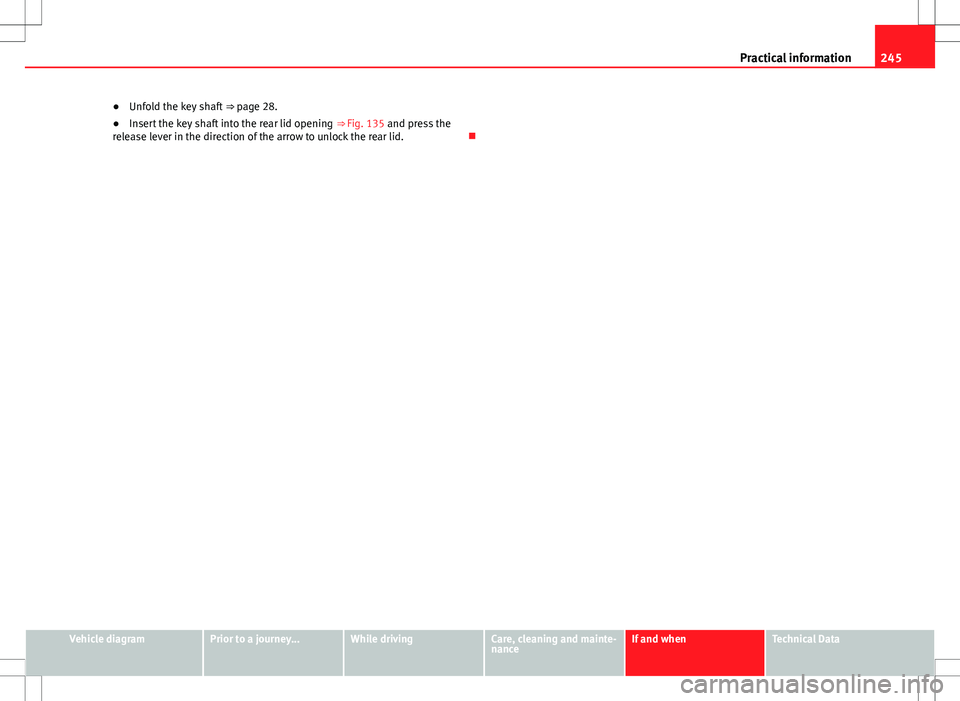
245
Practical information
● Unfold the key shaft ⇒ page 28.
● Insert the key shaft into the rear lid opening ⇒ Fig. 135 and press the
release lever in the direction of the arrow to unlock the rear lid.
Vehicle diagramPrior to a journey...While drivingCare, cleaning and mainte-
nanceIf and whenTechnical Data
Page 248 of 308
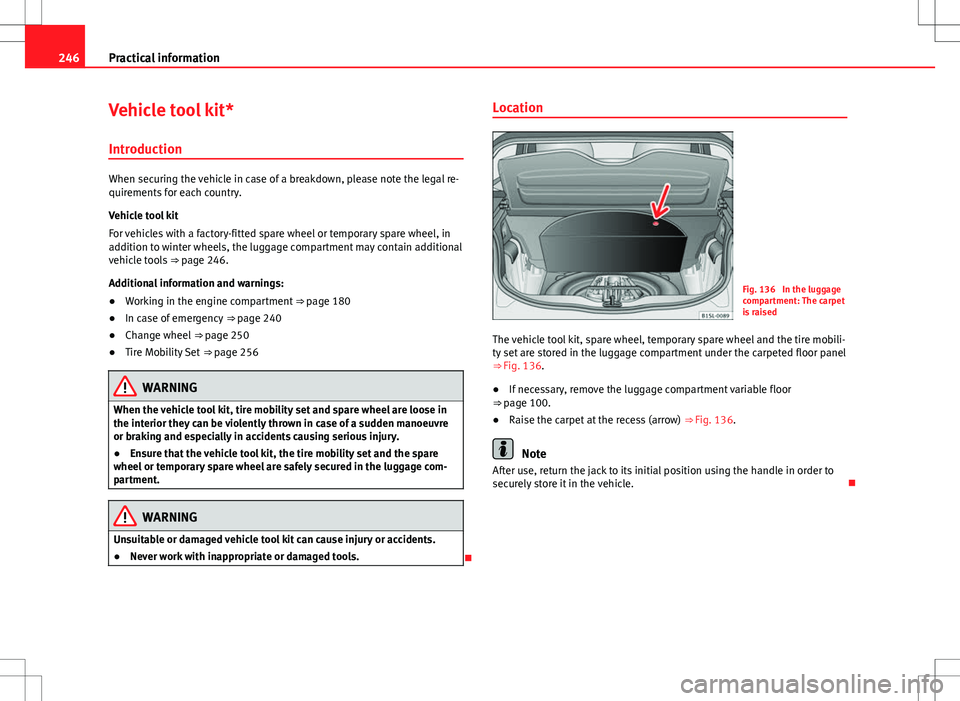
246Practical information
Vehicle tool kit*
Introduction
When securing the vehicle in case of a breakdown, please note the legal re-
quirements for each country.
Vehicle tool kit
For vehicles with a factory-fitted spare wheel or temporary spare wheel, in
addition to winter wheels, the luggage compartment may contain additional
vehicle tools ⇒ page 246.
Additional information and warnings:
● Working in the engine compartment ⇒ page 180
● In case of emergency ⇒ page 240
● Change wheel ⇒ page 250
● Tire Mobility Set ⇒ page 256
WARNING
When the vehicle tool kit, tire mobility set and spare wheel are loose in
the interior they can be violently thrown in case of a sudden manoeuvre
or braking and especially in accidents causing serious injury.
● Ensure that the vehicle tool kit, the tire mobility set and the spare
wheel or temporary spare wheel are safely secured in the luggage com-
partment.
WARNING
Unsuitable or damaged vehicle tool kit can cause injury or accidents.
● Never work with inappropriate or damaged tools.
Location
Fig. 136 In the luggage
compartment: The carpet
is raised
The vehicle tool kit, spare wheel, temporary spare wheel and the tire mobili-
ty set are stored in the luggage compartment under the carpeted floor panel
⇒ Fig. 136.
● If necessary, remove the luggage compartment variable floor
⇒ page 100.
● Raise the carpet at the recess (arrow) ⇒ Fig. 136.
Note
After use, return the jack to its initial position using the handle in order to
securely store it in the vehicle.
Page 249 of 308

247
Practical information
Components
Fig. 137 Components of
the vehicle tool kit
The set of on-board tools depends on the vehicle equipment. The following
is a description for a vehicle with all options.
The individual elements of the vehicle tools ⇒ Fig. 137
Screwdriver with hexagon socket in the handle for screwing and un-
screwing the wheel bolts once loosened. The screwdriver bit is inter-
changeable. The screwdriver may be found underneath the wheel span-
ner.
Adapter for antitheft bolt. SEAT recommend you carry the wheel bolt
adapter in the vehicle tool kit at all times. The code number of the anti-
theft wheel bolt is stamped on the front of the adapter. In case it is lost,
another adapter can be ordered using this number. Note the antitheft
bolt code for the wheels and keep it in a place other than the vehicle.
Towing eye, removable.
Wire hook for pulling off the wheel trims, integral hubcaps and the
wheel bolt caps.
1
2
34
Jack. Before storing the jack in the tool kit, fold its hook. The crank
must then be folded tight against the side of the jack in order for it to
be safely stored.
Wheel spanner.
5
6
Vehicle diagramPrior to a journey...While drivingCare, cleaning and mainte-
nanceIf and whenTechnical Data
Page 250 of 308

248Practical information
Wheel trims
Introduction
Additional information and warnings:
● Caring for and cleaning the vehicle exterior ⇒ page 197
● Vehicle tools ⇒ page 246
● Change wheel ⇒ page 250
● Tire Mobility Set ⇒ page 256
WARNING
If the wheel trims are not appropriate or not fitted correctly, they could
cause major accidents or damage.
● Incorrectly mounted wheel trims may come off while driving and en-
danger other road users.
● Damaged trims must never be mounted on the wheels.
● Always ensure that the brake ventilation and cooling is not cut off or
blocked. This is also valid if hubcaps are fitted later. If there is not
enough air, you may require significantly longer braking distances.
CAUTION
Remove and remount wheel trims taking care to avoid damage to the vehi-
cle. Hubcaps
Fig. 138 Remove the
hubcap of the steel wheel
trim
In order to access the wheel bolts, first remove the hubcap.
Removing and fitting the hubcap
● To remove, take the vehicle tool kit wire hook and attach it to the edge of
the wheel trim ⇒ Fig. 138.
● Remove the trim by pulling it in the direction of the arrow.
● To replace the hubcap , press the hubcap against the trim until it clicks
into place.
The caps protect the wheel bolts and should be remounted after changing
the tyre.